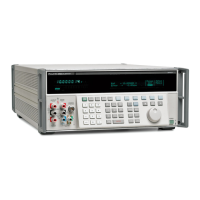Front Panel Operation
Introduction to Offset, Scale, and Linearity Errors 4
4-43
4-45. Scale Error
Scale error, sometimes referred to as gain error, occurs when the slope of the meter's
response curve deviates from one. A meter with only scale error (no offset or linearity
error), will read 0V when 0V is applied, but will read something other than 10V when
10V is applied. For example, if a meter reads 19.900V when 19.903V is applied, the
meter has a scale error of -3 mV. To isolate scale error, offset error must first be
subtracted. Scale error is then simply the error measured near the full-scale endpoint, or:
Scale Error =
(Reference full scale)-(Adjusted Calibrator Setting)
(Reference full scale)
Where “Adjusted calibrator setting” is the adjusted output (using the knob) that results in
the UUT correctly reading “nominal full-scale.” Select a point just down from the UUT
full-scale endpoint for nominal full-scale. This keeps the UUT from ranging while you
make adjustments. For example, you might use 19.9V as the nominal full-scale for a
UUT that ranges at 20V.
The example in Figure 4-8 assumes no offset error. The formula for scale error yields:
Scale Error =
19 9 19 903
19 9
..
.
−
= -0.000151=-0.0151%
CALIBRATOR
SETTING
0
METER READING
19.903V
19.9V
SCALE
ERROR =
-3 mV
19.9V
IDEAL
ACTUAL
Figure 4-8. Scale Error

